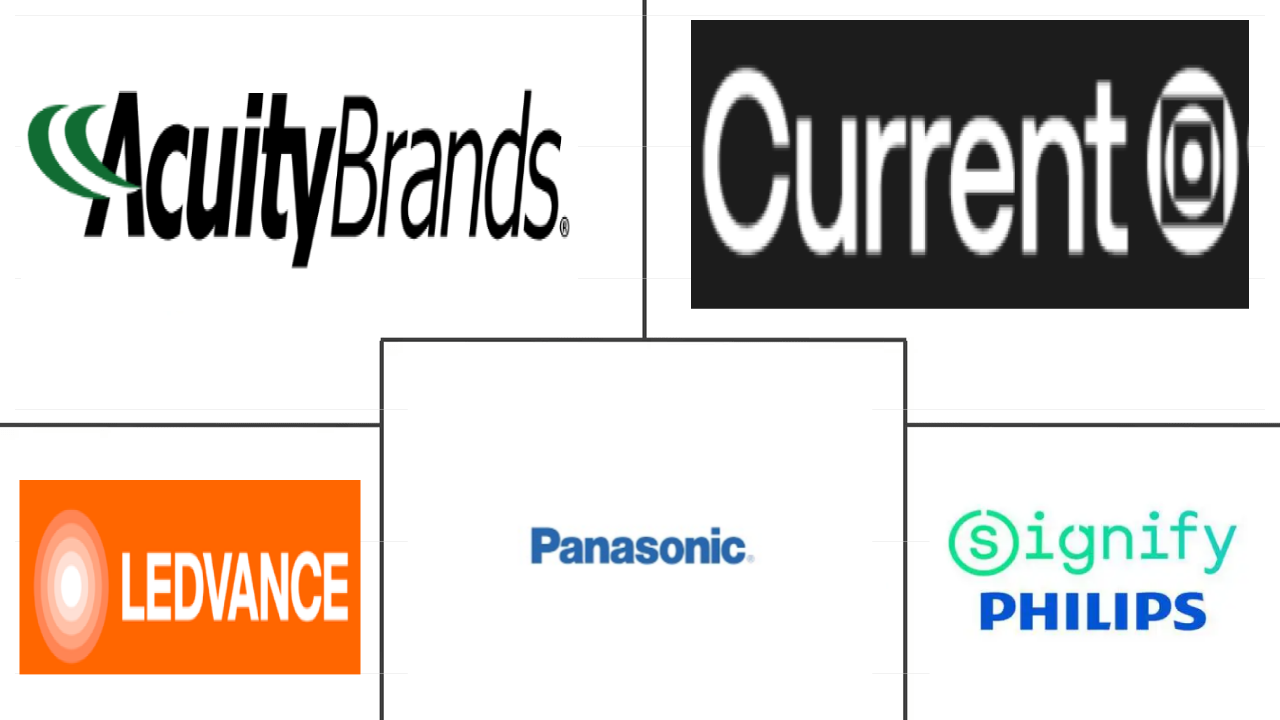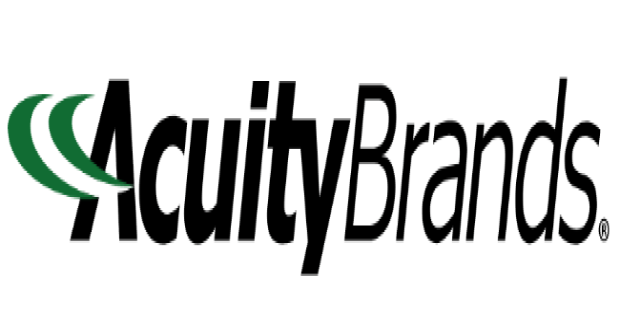Market Size of north america indoor led lighting Industry
| Icons | Lable | Value |
|---|---|---|
|
|
Study Period | 2017 - 2030 |
|
|
Market Size (2024) | USD 6.30 Billion |
|
|
Market Size (2030) | USD 7.63 Billion |
|
|
Largest Share by Indoor Lighting | Commercial |
|
|
CAGR (2024 - 2030) | 3.26 % |
|
|
Largest Share by Country | United States |
|
|
Market Concentration | High |
Major Players |
||

|
||
|
*Disclaimer: Major Players sorted in no particular order |
North America Indoor LED Lighting Market Analysis
The North America Indoor LED Lighting Market size is estimated at 6.30 billion USD in 2024, and is expected to reach 7.63 billion USD by 2030, growing at a CAGR of 3.26% during the forecast period (2024-2030).
6.30 Billion
Market Size in 2024 (USD)
7.63 Billion
Market Size in 2030 (USD)
0.96 %
CAGR (2017-2023)
3.26 %
CAGR (2024-2030)
Largest Segment by Indoor Lighting
65.14 %
value share, Commercial, 2023
The United States contributes more than 9.1 billion sq. ft of office inventory space in the suburban and downtown regions. Growth was experienced in the Class A office market in Canada.
Largest Segment by Commercial
28.90 %
value share, Retail, 2023
The COVID-19 pandemic accelerated this transition as e-commerce became the default setting for many homebound consumers. The e-commerce industry is leading to a permanent shift in retail.
Largest by Country
84.86 %
value share, United States, 2023
The United States is the major country in the North American LED lighting market. The growing number of manufacturing facilities in the country is expected to create more demand for indoor LEDs.
Fastest-growing Segment by Country
3.31 %
Projected CAGR, United States, 2024-2030
The United States has the largest retail market in the world and is home to many of the world's largest retailers. Total retail sales grew by 8.9% Y-o-Y in 2022.
Leading Market Player
38.96 %
market share, ACUITY BRANDS INC., 2022

Acuity Brands develops technology that saves customers energy and reduces their carbon footprint. The company works to mitigate the effects of climate change, maximizing the impact of technology.
Increasing demand for industrial production, rising need for storage space, and increasing availability of office space are driving the demand for the market
- In terms of value, in 2023, commercial accounted for the majority of the share, followed by residential, industrial and warehouse (I&W), and agricultural. The market share is expected to gain in I&W and a small reduction in the remaining divisions in years. The US industries faced several internal and external headwinds, such as weak domestic consumption, semiconductor crunch, plant closures, and supply chain disruptions caused by the surge of COVID-19. Further, the United States sustained its industrial production in 2021. In 2021, the United States produced a total of USD 2,497.1 billion, an increase of 11.55% compared to 2020.
- In the United States, industrial production grew by 0.2% Y-o-Y in May 2023, after an upwardly revised rise of 0.4% in April 2023. Mining went up by 5%, utilities dropped by 3.8%, and manufacturing fell by 0.3%. Mexico produced a total of USD 230.07 billion, an increase of manufacturing output of 21.44% compared to 2020. Thus, the growing industrial production in this region is expected to create more demand for Indoor lighting in the coming years.
- The Canadian commercial real estate sector has been facing increasing market volatility since the middle of 2022. The financial, technology, and life sciences sectors are the drivers of demand for office space, with leasing rates increasing compared to 2021. Employment gains were registered in the construction, warehouse, and other sectors. In December 2022, 104 thousand jobs were added in Canada. The availability of national offices in Q4 of 2022 and accounted for 16.5%, which was higher than in Q3 of 2022 and Q4 of 2021. These instances are expected to create more demand for office spaces in the near future, which will result in creating more need for indoor lighting products.
The growing number of manufacturing facilities, house owners, and retail facilities is expected to drive the demand for indoor lighting
- In terms of value and volume, in 2023, the United States accounted for the majority of the share, followed by the Rest of North America. The market share is expected to decline for the Rest of North America and gain for the United States with less fluctuation in the coming years. Demand for EVs surged across many countries in North America, resulting in increasing manufacturing facilities. In March 2022, VinFast, a Vietnamese automaker, planned to establish an all-electric SUV plant in Chatham County with an investment of USD 4 billion. In April 2023, Ford announced its new manufacturing hub in Canada, with an investment of USD 1.3 billion. The increase in manufacturing facilities is expected to create more demand for indoor LEDs in the market.
- In 2022, the largest number of startups in the United States focused on retail (15.05%), including brick-and-mortar stores and an e-commerce business. Restaurants and other food-related businesses account for 13.71% of the startups. The increasing number of startups is expected to create more need for indoor LEDs in the region.
- The number of households in the United States grew from 128.45 million to 131.2 million between 2020 and 2022. Further, the number of privately owned dwelling units authorized by building permits in May 2023 was 1,491,000. This is 5.2% more than the April 2023 rate, which was increased from 1,417,000. The number of privately owned homes started in May 2023 was 1,631,000. This is 5.7% above the May 2022 rate of 1,543,000. Thus, the growing number of households and house owners is expected to create more demand for indoor LEDs in the region.
North America Indoor LED Lighting Industry Segmentation
Agricultural Lighting, Commercial, Industrial and Warehouse, Residential are covered as segments by Indoor Lighting. United States are covered as segments by Country.
- In terms of value, in 2023, commercial accounted for the majority of the share, followed by residential, industrial and warehouse (I&W), and agricultural. The market share is expected to gain in I&W and a small reduction in the remaining divisions in years. The US industries faced several internal and external headwinds, such as weak domestic consumption, semiconductor crunch, plant closures, and supply chain disruptions caused by the surge of COVID-19. Further, the United States sustained its industrial production in 2021. In 2021, the United States produced a total of USD 2,497.1 billion, an increase of 11.55% compared to 2020.
- In the United States, industrial production grew by 0.2% Y-o-Y in May 2023, after an upwardly revised rise of 0.4% in April 2023. Mining went up by 5%, utilities dropped by 3.8%, and manufacturing fell by 0.3%. Mexico produced a total of USD 230.07 billion, an increase of manufacturing output of 21.44% compared to 2020. Thus, the growing industrial production in this region is expected to create more demand for Indoor lighting in the coming years.
- The Canadian commercial real estate sector has been facing increasing market volatility since the middle of 2022. The financial, technology, and life sciences sectors are the drivers of demand for office space, with leasing rates increasing compared to 2021. Employment gains were registered in the construction, warehouse, and other sectors. In December 2022, 104 thousand jobs were added in Canada. The availability of national offices in Q4 of 2022 and accounted for 16.5%, which was higher than in Q3 of 2022 and Q4 of 2021. These instances are expected to create more demand for office spaces in the near future, which will result in creating more need for indoor lighting products.
| Indoor Lighting | |||||
| Agricultural Lighting | |||||
| |||||
| Industrial and Warehouse | |||||
| Residential |
| Country | |
| United States | |
| Rest of North America |
North America Indoor LED Lighting Market Size Summary
The North America Indoor LED Lighting Market is poised for steady growth, driven by increasing demand across various sectors such as commercial, residential, industrial, and agricultural. The market is experiencing a shift in demand dynamics, with commercial lighting currently holding the largest share, followed by residential and industrial sectors. The United States, in particular, is a significant contributor to the market, with its industrial production and manufacturing facilities expanding, thereby boosting the demand for indoor LED lighting. The Canadian market is also witnessing growth due to the rising demand for office spaces and the increasing number of jobs in sectors like construction and warehousing. These trends are expected to further fuel the need for advanced lighting solutions in the region.
The market landscape is characterized by a high level of consolidation, with major players like ACUITY BRANDS INC., Current Lighting Solutions LLC, LEDVANCE GmbH, Panasonic Holdings Corporation, and Signify (Philips) dominating the scene. The adoption of LED lighting is being supported by various government initiatives and policies aimed at reducing energy consumption, such as Canada's ENERGY STAR program. Additionally, the introduction of new products and technologies by leading companies is enhancing the market's growth prospects. The increasing urbanization, coupled with the rise in disposable income and construction activities, is expected to further drive the penetration of LED lighting solutions across North America, making it a key market for future investments.
North America Indoor LED Lighting Market Size - Table of Contents
-
1. MARKET SEGMENTATION (includes market size in Value in USD and Volume, Forecasts up to 2030 and analysis of growth prospects)
-
1.1 Indoor Lighting
-
1.1.1 Agricultural Lighting
-
1.1.2 Commercial
-
1.1.2.1 Office
-
1.1.2.2 Retail
-
1.1.2.3 Others
-
-
1.1.3 Industrial and Warehouse
-
1.1.4 Residential
-
-
1.2 Country
-
1.2.1 United States
-
1.2.2 Rest of North America
-
-
North America Indoor LED Lighting Market Size FAQs
How big is the North America Indoor LED Lighting Market?
The North America Indoor LED Lighting Market size is expected to reach USD 6.30 billion in 2024 and grow at a CAGR of 3.26% to reach USD 7.63 billion by 2030.
What is the current North America Indoor LED Lighting Market size?
In 2024, the North America Indoor LED Lighting Market size is expected to reach USD 6.30 billion.

